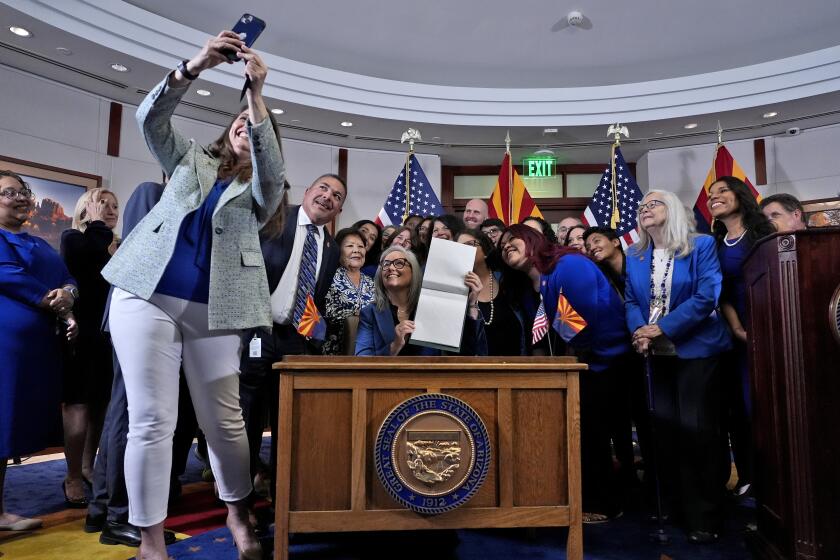The GOP’s McCarthy gene
Ever since the election, partisans within the Republican Party and observers outside it have been speculating wildly about what direction the GOP will take to revive itself from its disaster. Or, more specifically, which wing of the party will prevail in setting the new Republican course -- whether it will be what conservative writer Kathleen Parker has called the “evangelical, right-wing, oogedy-boogedy” branch or the more pragmatic, intellectual, centrist branch. To determine the answer, it helps to understand exactly how Republicans arrived at this spot in the first place.
The creation myth of modern conservatism usually begins with Barry Goldwater, the Arizona senator who was the party’s presidential standard-bearer in 1964 and who, even though he lost in one of the biggest landslides in American electoral history, nevertheless wrested the party from its Eastern establishment wing. Then, Richard Nixon co-opted conservatism, talking like a conservative while governing like a moderate, and drawing the opprobrium of true believers. But Ronald Reagan embraced it wholeheartedly, becoming the patron saint of conservatism and making it the dominant ideology in the country. George W. Bush picked up Reagan’s fallen standard and “conservatized” government even more thoroughly than Reagan had, cheering conservatives until his presidency came crashing down around him. That’s how the story goes.
But there is another rendition of the story of modern conservatism, one that doesn’t begin with Goldwater and doesn’t celebrate his libertarian orientation. It is a less heroic story, and one that may go a much longer way toward really explaining the Republican Party’s past electoral fortunes and its future. In this tale, the real father of modern Republicanism is Sen. Joe McCarthy, and the line doesn’t run from Goldwater to Reagan to George W. Bush; it runs from McCarthy to Nixon to Bush and possibly now to Sarah Palin. It centralizes what one might call the McCarthy gene, something deep in the DNA of the Republican Party that determines how Republicans run for office, and because it is genetic, it isn’t likely to be expunged any time soon.
The basic problem with the Goldwater tale is that it focuses on ideology and movement building, which few voters have ever really cared about, while the McCarthy tale focuses on electoral strategy, which is where Republicans have excelled.
McCarthy, Wisconsin’s junior senator, was the man who first energized conservatism and made it a force to reckon with. When he burst on the national scene in 1950 waving his list of alleged communists who had supposedly infiltrated Harry Truman’s State Department, conservatism was as bland, temperate and feckless as its primary congressional proponent, Ohio Sen. Robert Taft, known fondly as “Mister Conservative.” Taft was no flamethrower. Though he was an isolationist and a vehement opponent of FDR, he supported America’s involvement in the war after Pearl Harbor and had even grudgingly come to accept the basic institutions of the New Deal. He was also no winner. He had contested and lost the Republican presidential nomination to Wendell Willkie in 1940, Thomas Dewey in 1948 and Dwight Eisenhower in 1952, three men who were regarded as much more moderate than he.
McCarthy was another thing entirely. What he lacked in ideology -- and he was no ideologue at all -- he made up for in aggression. Establishment Republicans, even conservatives, were disdainful of his tactics, but when those same conservatives saw the support he elicited from the grass-roots and the press attention he got, many of them were impressed. Taft, no slouch himself when it came to Red-baiting, decided to encourage McCarthy, secretly, sealing a Faustian bargain that would change conservatism and the Republican Party. Henceforth, conservatism would be as much about electoral slash-and-burn as it would be about a policy agenda.
For the polite conservatives, McCarthy was useful. That’s because he wasn’t only attacking alleged communists and the Democrats whom he accused of shielding them. He was also attacking the entire centrist American establishment, the Eastern intellectuals and the power class, many of whom were Republicans themselves, albeit moderate ones. When he began his investigation of the Army, he even set himself against his own Republican president, who had once commanded that service. In the end, he was censured in 1954, not for his recklessness about alleged communists but for his recklessness toward his fellow senators. Moderate Republicans, not Democrats, led the fight against him. His intemperance disgusted them as much as it emboldened his fans, Goldwater among them.
But if McCarthy had been vanquished -- he died three years later of cirrhosis from drinking -- McCarthyism was only just beginning. McCarthyism is usually considered a virulent form of Red-baiting and character assassination. But it is much more than that. As historian Richard Hofstadter described it in his famous essay, “The Paranoid Style in American Politics,” McCarthyism is a way to build support by playing on the anxieties of Americans, actively convincing them of danger and conspiracy even where these don’t exist.
McCarthy, a Catholic, was especially adept at nursing national resentments among the sorts of people that typically did not vote Republican. He stumbled onto the fact that many of these people in postwar America were frightened and looking for scapegoats. He provided them, and in doing so not only won millions of adherents but also bequeathed to his party a powerful electoral bludgeon that would eventually drive out the moderates from the GOP (posthumous payback) before it drove the Democrats from the White House.
In a way, Goldwater was less a fulfillment of McCarthy conservatism than a slight diversion from it. Goldwater was ideological -- an economic individualist. He hated government more than he loved winning, and though he was certainly not above using the McCarthy appeal to resentment or accusing his opponents of socialism, he lacked McCarthy’s blood- lust. McCarthy’s real heir was Nixon, who mainstreamed McCarthyism in 1968 by substituting liberals, youth and minorities for communists and intellectuals, and fueling resentments as McCarthy had. In his 1972 reelection, playing relentlessly on those resentments, Nixon effectively disassembled the old Roosevelt coalition, peeling off Catholics, evangelicals and working-class Democrats, and changed American politics far more than Goldwater ever would.
Today, these former liberals are known as Reagan Democrats, but they were Nixon voters before they were Reagan voters, and they were McCarthy supporters before they were either. A good deal of McCarthy’s support came from Catholics and evangelical Protestants who, along with Southerners, would form the basis of the new conservative coalition. Nixon simply mastered what McCarthy had authored. You demonize the opposition and polarize the electorate to win.
Reagan’s sunny disposition and his willingness to compromise masked the McCarthyite elements of his appeal, but Reaganism as an electoral device was unique to Reagan and essentially died with the end of his presidency. McCarthyism, on the other hand, which could be deployed by anyone, thrived. McCarthyism was how Republicans won. George H.W. Bush used it to get himself elected, terrifying voters with Willie Horton. And his son, under the tutelage of strategist Karl Rove, not only got himself reelected by convincing voters that John Kerry was a coward and a liar and would hand the nation over to terrorists, which was pure McCarthyism, he governed by rousing McCarthyite resentments among his base.
Republicans continue to push the idea that this is a center-right country and that Americans have swooned for GOP anti-government posturing all these years, but the real electoral bait has been anger, recrimination and scapegoating. That’s why John McCain kept describing Barack Obama as some sort of alien and why Palin, taking a page right out of the McCarthy playbook, kept pushing Obama’s relationship with onetime radical William Ayers.
And that is also why the Republican Party, despite the recent failure of McCarthyism, is likely to keep moving rightward, appeasing its more extreme elements and stoking their grievances for some time to come. There may be assorted intellectuals and ideologues in the party, maybe even a few centrists, but there is no longer an intellectual or even ideological wing. The party belongs to McCarthy and his heirs -- Rush Limbaugh, Sean Hannity, Bill O’Reilly and Palin. It’s in the genes.
Neal Gabler is the author of many books, including, most recently, “Walt Disney: The Triumph of the American Imagination.”
More to Read
Get the L.A. Times Politics newsletter
Deeply reported insights into legislation, politics and policy from Sacramento, Washington and beyond. In your inbox three times per week.
You may occasionally receive promotional content from the Los Angeles Times.










